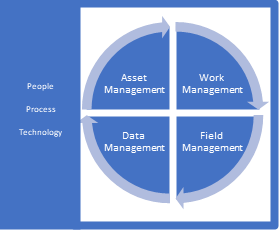
Risk mitigation is the key reason to know the probability of failure of utility assets. Unfortunately, the utilities that know that best, are the ones that have had one or more catastrophic asset failures that jeopardized the safety of people, damaged property and interrupted service. Federal and state regulatory agencies are stepping in more frequently to provide guidance and rules for utilities, as seen with the recent reauthorization of the Pipeline Safety Act (August 6, 2020)1. This, in turn, is placing Public Utility Commissions (PUCs) under growing pressure to better regulate the utilities, resulting in additional requirements for utilities to provide risk mitigation information and strategies. One clear example of this is the Geographic Information System (GIS) Data Reporting Requirements and Schema for California Electrical Corporations2 issued by the California Public Utilities Commission’s Wildfire Safety Division as part of their wildfire mitigation plan for 2020’s Wildfire Safety Division as part of their wildfire mitigation plan for 2020.
Given the increased public interest in the reliability of utility networks, many leading utilities are turning towards international standards and frameworks to help them navigate the complexities of asset management. The ISO 55000 Asset Management Standard calls for a repeatable, justifiable, and auditable asset management process that encompasses people, processes and technology. When this comes back to the question of risk mitigation, it is important to understand how the data and information collected throughout the entire asset lifecycle are critical to making educated and safe decisions about managing risk.

From project conceptualization through decommissioning, an asset touches almost all areas of a utility’s business operations. Each of these areas requires information about the asset to make business decisions, whether it is financial, physical, or operational. When it comes to a topic as critical as risk mitigation, all parties must come to the table with an open mind and willingness to collaborate across departments. The identification and prioritization of threats against utility networks requires that utilities effectively invest their limited budget dollars. The enablement of this investment is brought about by having a clear and accurate understading of the condition, operation, and maintenance requirements of assets in the utility’s portfolio.
Work Management
Whether it is design, maintenance, or decommissioning, effective work management and data collection is critical to managing risk throught the lifecycle of an asset. Planning work is a complicated activity and has a direct impact on the health and safety of utility employees and the public. Planners must be able to account for all ongoing work across the network, know impacted assets and downstream effects of work being performed, and balance cost, safety and efficiency to minimize network downtime while continuing to serve their customers.
The lack of a centralized view into all work and an understanding of the condition of the impacted assets can lead to incidents, unsafe worksites, and/or service interruptions for customers. In the case of the 2018 Merrimack Valley gas explosion, the procedure outlined for a pipe replacement maintenance job did not account for an operational regulator’s pressure sensing lines when depressurizing a retired pipe, causing the distribution network to be over-pressured with natural gas. Although this incident was low probability, the team was working with incomplete asset information the consequences of the failure was high, leading to one casualty, explosions and fires in over forty homes, and recovery costs estimated to be more than USD$1 Billion.
So how can these sorts of issues be avoided? While a single action alone cannot resolve these types of oversight, implementing standardized procedures across the lifecycle of the asset can help. Collecting data about an asset every time it is touched in the field, developing threat evaluation criteria, performing risk ranking and developing mitigation plans, as well as involving all areas of the business in the responsibility to maintain a safe environment play a big part in transforming utilities’ ability to effectively manage risk.
Field Management
Field technicians and the role they play in the life of an asset are an often overlooked, critical part of asset risk mitigation. They are the utility’s eyes on the ground, collectors of asset condition information, and are often the first responders when something goes wrong. The ability for utilities to accurately identify the risk of failure of assets heavily relies on providing quality asset condition data for later analysis by decision-makers.
Providing a sound field data collection platform governed by an overarching technical and business strategy is critical to delivering accurate and consistent asset condition data to data repositories, and has been built into regulatory requirements over the last decade. Along with clear operational processes, supporting technology solutions should strive to meet some basic requirements, including:
- Providing a flexible mobile solution that allows technicians to simply and safely perform work
- Ability for technicians to proactively update incorrect asset attribute information on the fly
- Reduction of unstructured data in field forms, such as open–ended comments fields to capture asset condition or inspection notes
Historically, utilities have relied on comments to capture asset condition and/or work performed. However, given the unstructured nature of the comments, it is difficult to systematically analyze comments to identify asset failure risk. Utilities should ensure that their field data collection schema minimizes the use of unstructured data fields to leverage asset condition data for asset risk analysis and reporting. This would also reduce the manual work required to interpret and analyze data and drive decisions related to managing asset risk. To leverage existing asset data, some tools use neural language modeling technologies to turn unstructured data into structured data that is easily analyzed. With the improved ability analyze asset condition data, utilities will be able to more accurately identify and mitigate asset risk.
Data Management
Having appropriate, accurate, and consistent asset data also enables analysis to help utilities make fact-based, data-driven decisions related to asset risk mitigation strategies, predictive maintenance, and infrastructure investment programs. With good quality asset data, utilities can have a more accurate view of their enterprise asset risk, allowing them to prioritize high-risk assets by taking into account the probability and consequence of assets failing. This will improve the effectiveness of risk mitigation strategies, reducing potential threats to people and property due to asset failures. Historically, utilities have relied on paper-based processes to capture and store asset data, making improvements to asset data seem like a daunting task. When it comes to data quality, it can often be more valuable for utilities to improve how future data will be collected than to focus on cleaning up historical data. Cleansing of historical data, despite being labor intensive, is code required per PHMSA 192.1007(a)(3), and becoming increasingly important for electric utilities. This allows utilities to rely on asset data being collected today, while understanding the limitations that their historical asset data.
Utilities can also optimize their work management strategies by predicting which assets are more likely to fail sooner and implementing proactive inspection programs to target assets that are likely to fail. This gives utilities a better ‘bang for the buck’ as they’re targeting the right assets at the right time in their asset management programs.
Overall, quality data enables advanced asset condition analytics that helps utilities make better decisions about their maintenance programs, which optimizes their operations and increases the efficiency of their infrastructure investment programs when taking risk into account. Assigning owners of this asset data across the organization can help to ensure the right data is being collected and utilized at the right time to make the best possible decisions for the utility. In our Merrimack Valley example, knowing that the pressure sensor existed, was operational, and would behave the way it did ahead of time could have played part in helping avoid such incidents.
Asset Management
As utilities strive for risk-based, information-driven, planning and decision-making processes and activities (ISO55001:2014), all areas of operations will be impacted, both through process and technology. Given the historically fragmented development of operational solutions, modern utilities are being challenged with the need to take the information being stored in disparate, legacy solutions, and manage them effectively to create a comprehensive view of assets.
The adoption of Enterprise Asset Management (EAM) frameworks is becoming increasingly common for large utilities to help manage this challenge. With the advent of cloud computing and the adoption of data lakes, integrating asset data and creating an asset golden record has become more easily achievable than in the past. Integrating asset data from multiple systems can help utilities improve their data quality with the ability to validate overlapping asset data fields to identify data inconsistencies and create action plans to address existing data issues and to correct the root cause of data inconsistencies. At the same time, a single source of truth for asset data will promote more accurate and consistent reporting – a critical point of pressure for utilities from Public Utility Commissions.
Adopting standard policies and processes for Asset Management and risk mitigation, while supporting technology solutions that provide a 360 view of assets sets up utilities to quickly and effectively respond to changes coming from regulators. When new requirements are introduced, the centralized view of asset data allows for efficient assessment of asset health and risk indices, and the ability to quickly adapt to changes in process and data collection requirements to drive future network improvements.
Without quality asset data, work cannot be effectively planned. Without well-planned work and procedures, field technicians may face unsafe situations. Without field technicians maintaining the network and identifying asset condition, utilities could put themselves increasingly at risk of asset failure, incidents, and unreliable network operations that are critical for their communities to function.
In summary, an Asset Management Improvement Roadmap should include these actions:
- Data governance processes that enables the integration and tracking of asset data from multiple systems to improve existing data issues and correct the root cause of data inconsistencies.
- Effective work management planning to account for all ongoing work across the network, know impacted assets and downstream effects of work being performed, and balance cost, safety and efficiency to minimize network downtime while continuing to serve their customers.
- Standardized procedures across the lifecycle of the asset, collecting data about an asset every time it is touched in the field, and involving all areas of the business in the responsibility to maintain a safe environments.
- A sound field data collection platform governed by an overarching technical and business strategy to deliver accurate and consistent asset condition data to data repositories.
- Clear operational processes, supporting technology solutions should strive to meet some basic requirements, including appropriate, accurate, and consistent asset data with assigned data owners.
- Establishing a single source of truth for asset data to promote more accurate and consistent reporting and allow for later analysis by decision-makers.
For utilities to improve their ability to manage risk, the focus cannot be on a single area of the asset lifecycle alone. Approaching Asset Management challenges holistically, and developing repeatable, justifiable and auditable processes across the organization is key to successfully transforming all areas of utility operations. Every business line needs to be encouraged to think about what information is critical to their decision-making responsibilities and communicate within their organization to ensure that it is being collected and managed effectively. Risk mitigation is a team activity, and until utilities start to operate with the bigger picture in mind, they still have a ways to go before they can effectively manage risk.
1 This Act directs gas utilities to focus on improved field data collection and methane emission reduction requirements.
2These requirements present standards, schemas, and a schedule for submission of GIS data to the Division in support of its assessment of Wildfire Mitigation Plans.















